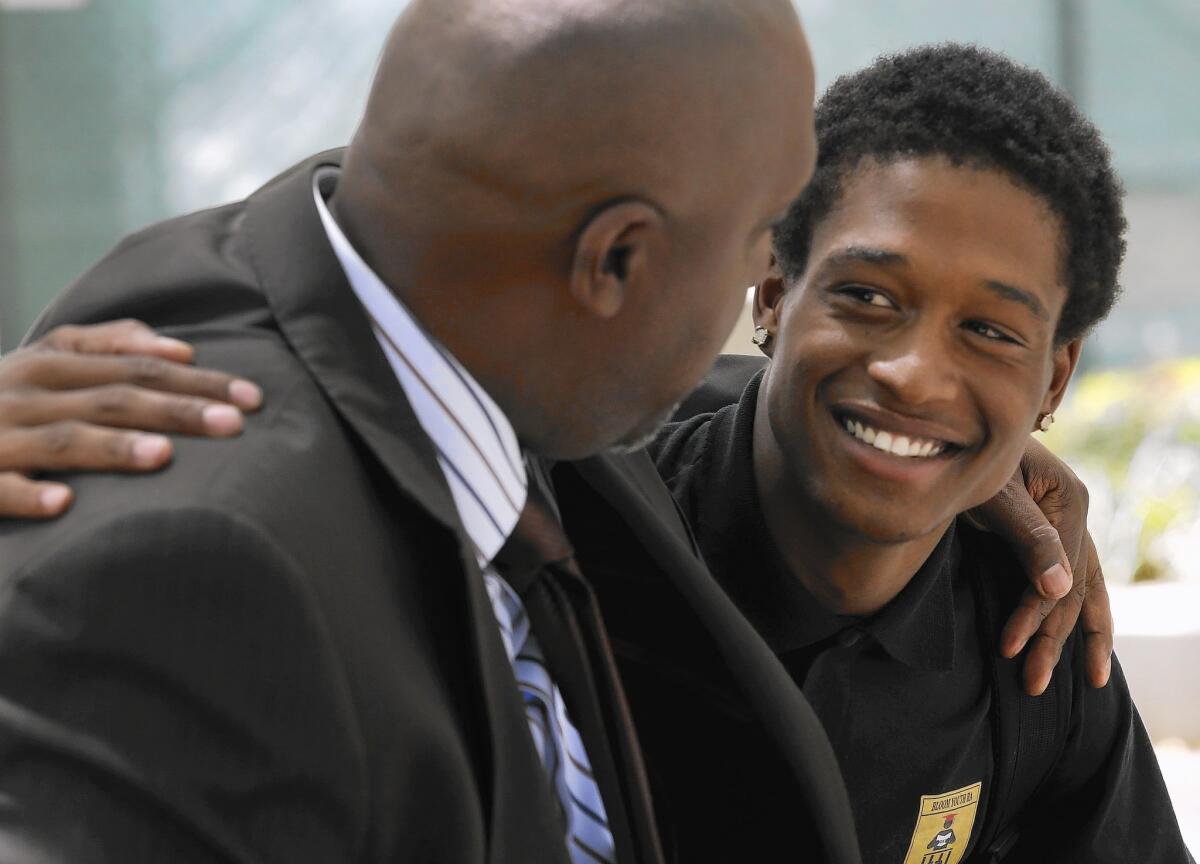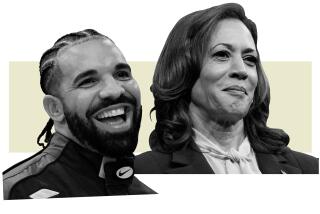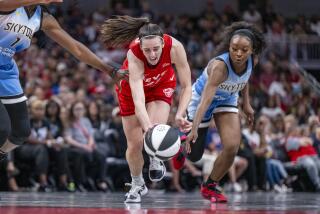Column: Black youths face an uphill battle — how do we help?

Semaj Clark was dealt a bad hand. Born to a teenage drug addict, he never knew his father. He was abused in foster care, he dropped out of high school, ran with hoodlums and built a long rap sheet that began with an arrest for burglary at age 12.
But with help from counselors, mentors, a probation officer and a college professor, Clark became a role model for up-from-the-streets success.
By 18, he’d enrolled in college, studied his way to a B average and become such a popular public speaker that he was invited to the White House to talk about raising black male achievement. His Facebook page sports a photo of him shaking hands with President Obama.
Yet Clark’s star status couldn’t protect him from the harsh reality of violent streets. Ten days ago, he was shot and paralyzed during a robbery attempt by three black teens in a Savannah, Ga., public housing project.
Clark was in Savannah to speak at a community safety forum aimed at reducing juvenile crime.
The irony doesn’t end there.
The 17-year-old arrested in his shooting was supposed to be in the audience at the conference, but he failed to show up.
Instead, police said, he and his buddies gathered nearby in the city’s tourist-friendly historic core, struck up a conversation with Clark and another Los Angeles youth, then led the pair to the housing complex a few blocks away. There, police said, the suspect pulled a gun, attempted to rob them and shot Clark in the back as he tried to flee.
The tragedy is a sobering reminder of how suddenly a success story can become an object lesson.
“My heart is broken,” said Charisse Bremond Weaver, president of the Brotherhood Crusade, which has provided mentors, counseling, and educational and financial support for hundreds of struggling youths, including Clark.
“Semaj is such a gifted young man. This is a different type of journey than any of us were expecting,” she said. “We’re just going to continue to love him and try to keep him in a positive space.”
Clark, who is hospitalized in Georgia, cried for hours when the doctor told him he’d never walk again.
“And you just can’t help thinking,” Bremond Weaver said, “Oh my goodness, why weren’t we there to protect him?”
::
I chronicled Clark’s climb in a column in May. He gave much of the credit to the BLOOM program — Building a Lifetime of Options and Opportunities for Men — sponsored by the Brotherhood Crusade.
Before a probation officer steered him to the group, Clark’s mindset wasn’t much different from that of those Georgia teens whose bullets sentenced him to a wheelchair.
“Where I come from, it’s cool to steal or smoke or have all these girls,” Clark told me last spring. “That’s what you have to do to have somebody respect you.”
BLOOM counselors introduced him to self-respect — and to better role models than the hustlers on his block: “They put you around successful black men that make you want to be that kind of person,” Clark said then.
But it takes more than good intentions and well-meaning mentors to salvage young men damaged by broken families, failing schools, dangerous streets and wrenching poverty.
Two months ago, another BLOOM youth, Kevin Clay Thomas, was shot to death at a Boyle Heights Metro station in what police believe was a dispute between black and Latino gangs.
“We’re not working with the A and B students. We’re working with kids who people have literally given up on,” Bremond Weaver said. “The question is how as a community can we change that narrative?”
::
That question is being asked all across the country, as part of a national movement launched last year by Obama, to lift, reform and inspire black and Latino boys and young men.
Clark was supposed to embody all that’s possible. I worry now about the message his plight might send to young men on the fence: You can’t outrun it or rise above it. There’s no amount of change that will keep trouble out of reach.
But those who know him best think Clark’s message will transcend that.
“There’s no other 18-year-old I know who’s had to overcome the kind of challenges he’s been through and has done so well,” said Cal Poly Pomona professor Renford Reese, who has Clark in two of his classes and runs the Reintegration Academy on campus, which educates formerly incarcerated young men. “He’s charismatic, he’s radiant, and he’s been out there grinding, always trying to do his best.”
Reese accompanied Clark and five other young men to the juvenile justice forum in Georgia. Clark “was the superstar,” he said.
Criminal justice professionals at the conference were so impressed that a steady stream of Savannah officials — judges, police officers, prosecutors, the police chief, the mayor — have visited Clark in the hospital, Reese said.
“That’s wonderful, it’s encouraging; he’s getting a lot of love,” but it’s not enough, Reese said.
“These young men are living in a culture of dysfunction.... People try to paint a rosy picture of black male transformation, but there’s nothing easy about it,” he said. He sometimes feels like Sisyphus, trying to roll a giant boulder to the top of a very steep hill.
“We have to look at what happens between the shootings,” he said. “My kids don’t need another protest. They need somebody to tutor them in math, to help buy their books. They need to earn enough to pay their rent.
“What happened is discouraging. I’m devastated,” Reese said. “But the answer is not to quit, but to double down. Semaj in a wheelchair? That means this crisis is as real as it gets.”
Twitter: @SandyBanksLAT
More to Read
Sign up for Essential California
The most important California stories and recommendations in your inbox every morning.
You may occasionally receive promotional content from the Los Angeles Times.











